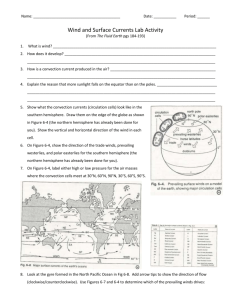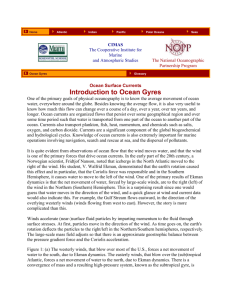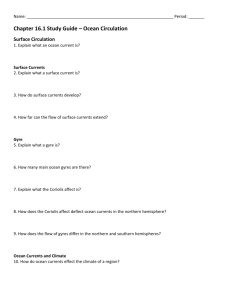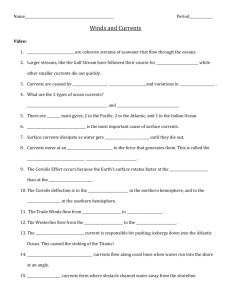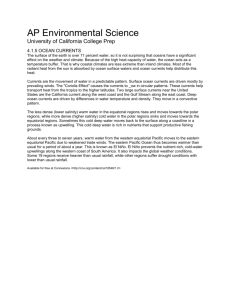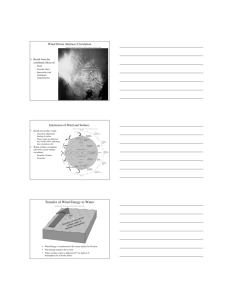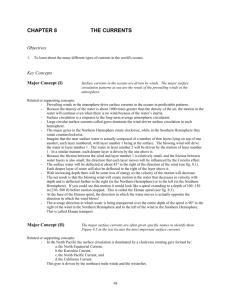P Topic 15 notes - The University of West Georgia
advertisement
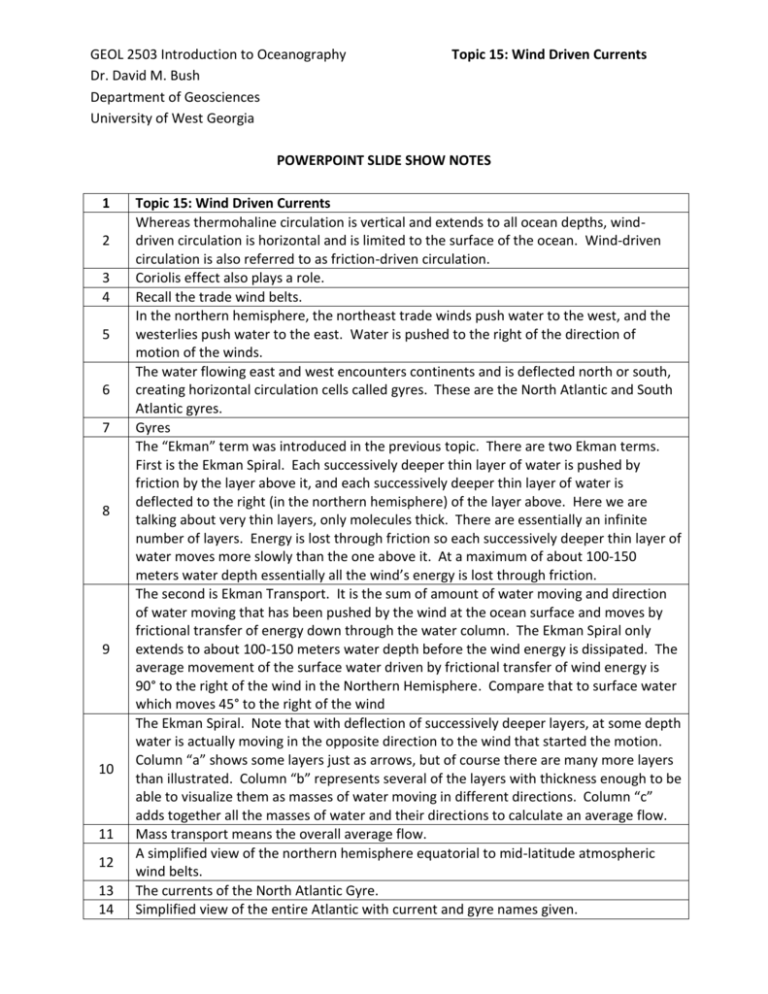
GEOL 2503 Introduction to Oceanography Dr. David M. Bush Department of Geosciences University of West Georgia Topic 15: Wind Driven Currents POWERPOINT SLIDE SHOW NOTES 1 2 3 4 5 6 7 8 9 10 11 12 13 14 Topic 15: Wind Driven Currents Whereas thermohaline circulation is vertical and extends to all ocean depths, winddriven circulation is horizontal and is limited to the surface of the ocean. Wind-driven circulation is also referred to as friction-driven circulation. Coriolis effect also plays a role. Recall the trade wind belts. In the northern hemisphere, the northeast trade winds push water to the west, and the westerlies push water to the east. Water is pushed to the right of the direction of motion of the winds. The water flowing east and west encounters continents and is deflected north or south, creating horizontal circulation cells called gyres. These are the North Atlantic and South Atlantic gyres. Gyres The “Ekman” term was introduced in the previous topic. There are two Ekman terms. First is the Ekman Spiral. Each successively deeper thin layer of water is pushed by friction by the layer above it, and each successively deeper thin layer of water is deflected to the right (in the northern hemisphere) of the layer above. Here we are talking about very thin layers, only molecules thick. There are essentially an infinite number of layers. Energy is lost through friction so each successively deeper thin layer of water moves more slowly than the one above it. At a maximum of about 100-150 meters water depth essentially all the wind’s energy is lost through friction. The second is Ekman Transport. It is the sum of amount of water moving and direction of water moving that has been pushed by the wind at the ocean surface and moves by frictional transfer of energy down through the water column. The Ekman Spiral only extends to about 100-150 meters water depth before the wind energy is dissipated. The average movement of the surface water driven by frictional transfer of wind energy is 90° to the right of the wind in the Northern Hemisphere. Compare that to surface water which moves 45° to the right of the wind The Ekman Spiral. Note that with deflection of successively deeper layers, at some depth water is actually moving in the opposite direction to the wind that started the motion. Column “a” shows some layers just as arrows, but of course there are many more layers than illustrated. Column “b” represents several of the layers with thickness enough to be able to visualize them as masses of water moving in different directions. Column “c” adds together all the masses of water and their directions to calculate an average flow. Mass transport means the overall average flow. A simplified view of the northern hemisphere equatorial to mid-latitude atmospheric wind belts. The currents of the North Atlantic Gyre. Simplified view of the entire Atlantic with current and gyre names given. 15 16 17 18 19 20 21 22 23 24 25 26 27 28 29 30 31 32 33 34 35 36 37 38 Global view of ocean currents. All driven by the trade winds plus blocking by continents. Move the continents and you change some of the currents. With no continents, currents would encircle the planet. Note the West Wind Drift near Antarctica. It is the only current that circles the globe. It is the current that drives the convergence that creates the northern limit of the Southern Ocean. Refer back to Topic 14, slide 24, with “elevated convergence” labeled in the northern and southern hemispheres. This is what those convergences look like. They are in the center of gyres. Sea level at the center of the convergences is a couple of meters higher than average sea level. It’s caused by water being pushed by the surface currents to the right in the northern hemisphere and to the left in the southern hemisphere. The center of the “hills” of water is offset to the west because of Earth’s rotation to the east. The mounds are located under the subtropical high atmospheric pressure zones. High atmospheric pressure means evaporation, so the sea surface is somewhat saltier than average seawater. The surface convergences keep water dynamically separated from water outside the gyres. In the northern hemisphere, the center of the North Atlantic Gyre is named the “Sargasso Sea.” Another use of the term “sea.” Ekman Transport drives the convergences. Cutaway view of the Sargasso Sea. Because of its difference in water chemistry, the Sargasso Sea supports some plants and animals not common outside of the gyre. It derives its name from sargassum, a floating seaweed plentiful in its waters. Effects of Ekman Transport Major North Atlantic Currents The North Atlantic Gyre system Other North Atlantic Currents Continuity currents Equatorial Countercurrents In all oceans, the north and south equatorial currents drive water to the western side of oceans which creates the equatorial countercurrents flowing back to the east. Ignore EUC. Current speed What is a knot? Current volume Volume of water moved by North Atlantic surface circulation. Note the volume of the Gulf Stream. Because of Earth’s eastward rotation, currents on the western side of ocean basins are bigger. Ocean surface currents play an important role in moderating Earth’s climate. Cold versus warm currents Surface Current Eddies Gulf Stream eddies Cold- and Warm-Cored Eddy Formation Image on the right is an enhanced satellite view of the Gulf Stream showing eddies. Eddies can be important for fishing and ship traffic. Certain kinds of fish are associated with slope (cold, lower salinity) versus Sargasso Sea water (warm, higher salinity). Also, a ship can get a boost in forward speed by sailing on one side or the other of an eddy, depending on the eddy’s rotation and the ship’s direction of travel. Langmuir Circulation Dynamics of Langmuir Circulation. This is a small scale, surface process. Watch for these tell-tale trails when flying over open ocean. Now is a good time to reflect back on the Franklin-Folger Map of Gulf Stream, and other 39 40 41 42 43 44 45 46 47 48 sailing expeditions we introduced in Topic 1. Think of how sailors took advantage surface circulation long before they knew exactly what was driving the system. We mentioned drifting buoys when discussing El Niño. Here is an example of a low-tech drifter. Some of the more important ocean surface currents are numbered. Make sure you can identify them and know if they are warm or cold currents. The next seven slides show one current per slide. Agulhas Current Benguela Current Brazil Current California Current Equatorial Countercurrent Kuroshio Current Peru Current

